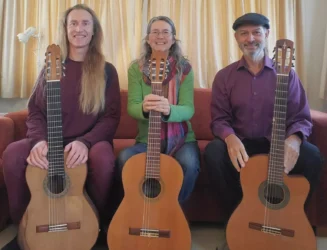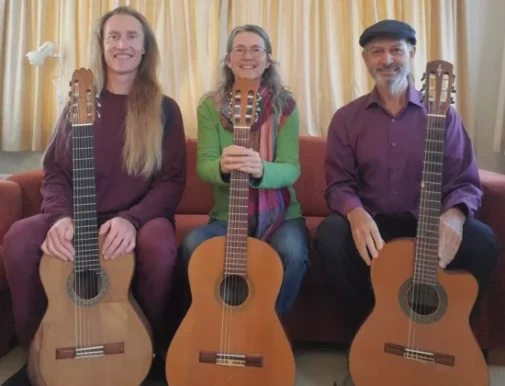 New Zealand Bemd, Tárrega, Lauro, Villa Lobos, Myers, Witten-Hannah, Albéniz: Acoustique Guitar Ensemble (Sasha Witten-Hannah, Yolanda van den Bemd, Len Matthews). Old Library, Whangarei, New Zealand, 10.11.2024. (PSe)
New Zealand Bemd, Tárrega, Lauro, Villa Lobos, Myers, Witten-Hannah, Albéniz: Acoustique Guitar Ensemble (Sasha Witten-Hannah, Yolanda van den Bemd, Len Matthews). Old Library, Whangarei, New Zealand, 10.11.2024. (PSe)

The duo originally booked for this, the final recital of Whangarei Music Society’s 2024 season, had to withdraw due to personal circumstances. It looked as though WMS would have to cancel. I gather that, at nigh-on the Eleventh Hour, Sasha Witten-Hannah (one of the aforementioned duo) offered the services of another group he is involved with. For WMS, this amounted to a shot in the dark, because the Acoustic Guitar Ensemble was an entirely unknown quantity. More to the point, it left this S&H reviewer in a bit of a quandary – the apparently hastily-prepared programme leaflet told us nothing about the ensemble or its background, and afterwards I found the internet to be equally unforthcoming.
I fared better chasing up the individual players: Sasha Witten-Hannah is a professional guitarist and guitar teacher, his activities covering a wide range of genres and performance modes, from background music at functions, through actual domestic recitals, to solo classical concerts. Yolanda van den Bemd is a self-employed teacher (guitar, ukulele and piano), a composer – and a career consultant. Len Matthews, evidently enough, plays the guitar, but otherwise seems to have completely evaded the internet.
The ensemble appears to have been recently formed by a group of friends, apparently acting primarily as a ‘demonstrator’ of Yolanda’s pieces, which are mostly associated with her ‘Shimmering Ukulele Instrumentals Book’ and her projected ‘Guitar Instrumentals Book’, each containing 20 ensemble pieces graded by ability. The fact that this recital’s programme consists of a dozen of Yolanda’s ensemble pieces, set beside half a dozen classical guitar solos played by Sasha, would seem to bear out my guesswork.
Yolanda’s pieces, mingling classical part-playing with elements of melodic counterpoint, are cleverly designed, to be flexible in use and suitable for educational, social, and – as here – performance environments. The overall style is classical with a mildly ‘folksy’ flavour; they are short, simple in outline, easy-going, charming, and very pleasant on the ear.
Yet, I am duty-bound to say that the flexibility of use of these pieces really does not stretch as far as recital performance. Let me stress that this is not due to any lack of ‘quality’, but simply because the pieces are too similar to one another. In other words: if you hear two or more on the trot, they soon start to sound ‘samey’; and a suite of eleven tends to induce aural indigestion.
Mind you, they are not all entirely dressed in uniform. For instance, Bright Light involved some drumming with the fingers on the guitar’s woodwork; the rhythm of Intuition had a keener edge; Elody (‘melody’ minus ‘m’) conjured a faster feeling through the accompaniment’s running triplets, and had stresses hinting at the Spanish; and Swinging Summer had a distinctly jazzy, even ‘hippy’ feel, mildly redolent of the Beach Boys! Just these four would have formed a far more edifying recital suite.
After the interval, Yolanda and Len rested, whilst Sasha gave a varied solo mini-recital. Tárrega’s Recuerdos de la Alhambra was immediately more involving music, with Sasha’s fingers dancing through the accompaniment’s rapid figurations, and pointing up the sublime melody so that it seemed to ‘ride’ the ‘ripples’. Played without any perceptible break, Lauro’s Natalia and Venezuelan Waltz No.2, with more elaborate fingerings, were more directly drawn. As it passed from intricate but lively to more rhythmic and chordal, the teasing twiddles persisted, the music becoming more ‘amorous’ towards the end.
Sasha moved on to Villa Lobos’s Preludes Nos. 1 and 2, taking effective advantage of this music’s spicier harmonies, injecting plenty of sensual rubato and underlining the inherent vigour and elemental intensity. Then, ‘playful’ becomes the watchword, Sasha negotiating with aplomb the ups, downs and flighty tempo variations. Play is interrupted by a grim central episode, in which Sasha made a stark contrast of the growling and scurrying in the bass.
Sasha included Stanley Myers’s Cavatina, known to countless millions as the theme from The Deer Hunter, because this was what first drew him to the guitar. At one point, Sasha suffered a momentary hesitation – which just goes to show that this is not quite so easy as it sounds – but this paled to nothing against his affectionate playing and thoughtful balancing of tune and accompaniment.
This provided a convenient ‘excuse’ for a medley of his own compositions; and it was perhaps not surprising that the first seems to have been inspired by the Myers. These featured some neat harmonics and menacing sounds glowering beneath a brighter, merrier foreground. To some extent this medley paved the way for Albéniz’s widely popular Asturias, music rapid and accelerating, punctuated with fierce chords. Sasha painted an evocative picture in the tense central section, capturing well the music’s Moorish exoticism.
Finally, Sasha played Una Lagrima (‘A Teardrop’). The leaflet omitted the composer’s name; rather awkward, seeing as there are umpteen guitar pieces of that name – my guess (and it is just a guess!) is that this was Tárrega’s, nicely closing the circle. Another ‘rippling’ piece, but one subdued and tinged with sorrow, its melody emerged out of, but never entirely separated from, the tonal shifting of the rippling pattern. In Sasha’s hands, this was hypnotic.
The ensemble reassembled for the finale, Yolanda’s Courage, a work of a different order from those earlier pieces. It was healthily up-beat, its insistent rhythm a syncopated pulse further enlivened by teasing little slurs. The sound could be called ‘New Age Hippy’, not that it matters one way or the other; what matters is the music’s pervasive optimism and aspiration, that feeling of reaching for – and even touching – the sky. Overall, this was a splendid recital, not to mention a successful rescue mission – and really, the audience’s unusually warm applause summed it all up very nicely.
Paul Serotsky
